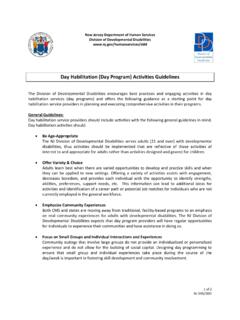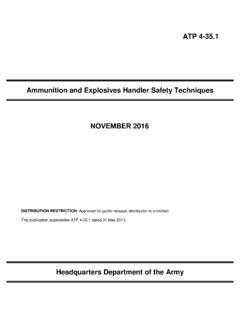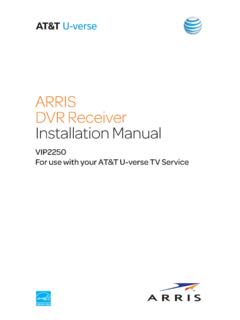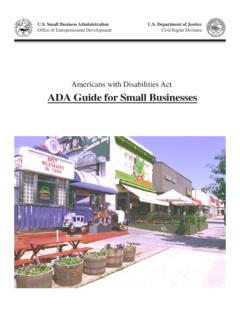Transcription of Headquarters, Department of the Army
1 ATP 4-12 Army Container Operations FEBRUARY 2021 DISTRIBUTION RESTRICTION: Approved for public release; distribution is unlimited. This publication supersedes ATP 4-12, dated 10 May 2013. Headquarters, Department of the Army This publication is available at the Army Publishing Directorate site ( ), and the Central Army Registry site ( ). *ATP 4-12 DISTRIBUTION RESTRICTION: Approved for public release; distribution is unlimited. *This publication supersedes ATP 4-12, dated 10 May 4-12 i Army Techniques Publication No. 4-12 Headquarters Department of the Army Washington, , 12 February 2021 Army Container Operations Contents Page iii INTRODUCTION .. v Chapter 1 FUNDAMENTALS OF CONTAINER OPERATIONS .. 1-1 Principles of Container Management .. 1-1 Department of Defense Container Policy .. 1-2 Container Categories .. 1-2 Container Management Roles and Responsibilities at the Strategic Level of Warfare.
2 1-3 Container Management Roles and Responsibilities at the Operational Level of Warfare .. 1-4 Container Management Roles and Responsibilities at the Tactical Level of Warfare .. 1-5 Chapter 2 CONTAINER PLANNING .. 2-1 Planning Considerations .. 2-1 Unit Container Planning .. 2-2 Containerized Ammunition .. 2-3 Container Procurement .. 2-4 Chapter 3 CONTAINER MANAGEMENT .. 3-1 Inter-Theater Container Management .. 3-1 Intra-Theater Container Management .. 3-2 Appendix A AUTOMATED INFORMATION SYSTEMS .. A-1 Appendix B CONTAINER AND DISTRIBUTION PLATFORMS .. B-1 GLOSSARY .. Glossary-1 REFERENCES .. References-1 INDEX .. Index-1 Contents ii ATP 4-12 12 February 2021 Figures Figure B-1. Example International Organization for Standardization serial number .. B-4 12 February 2021 ATP 4-12 iii Preface ATP 4-12, Army Container Operations, augments the sustainment principles, tactics, and procedures discussed in ADP 4-0, Sustainment, and FM 4-0, Sustainment Operations, by describing the Army s techniques for managing containers on land.
3 The principal audience for ATP 4-12 are all Army Soldiers and Civilians. Commanders and staffs of Army headquarters serving as joint task force or multinational headquarters should also refer to applicable joint or multinational doctrine concerning the range of military operations and joint or multinational forces. Trainers and educators throughout the Army will also use this manual. Commanders, staffs, and subordinates ensure that their decisions and actions comply with applicable United States, international, and in some cases host-nation laws and regulations. Commanders at all levels ensure that their Soldiers operate in accordance with the law of war and the rules of engagement (see FM 6-27/MCTP 11-10C.)ATP 4-12 uses joint terms where applicable. Selected joint and Army terms and definitions appear in both the glossary and the text. Terms for which ATP 4-12 is the proponent publication (the authority) are marked with an asterisk (*) in the glossary.
4 Definitions for which ATP 4-12 is the proponent publication are boldfaced in the text. These terms and their definitions will be in the next revision of FM For other definitions shown in the text, the term is italicized and the number of the proponent publication follows the definition. ATP 4-12 applies to the Active Army, Army National Guard/Army National Guard of the United States and United States Army Reserve unless otherwise stated. The proponent of ATP 4-12 is the United States Army Combined Arms Support Command. The preparing agency is the G-3/5/7 Doctrine Division, United States Army Combined Arms Support Command. Send written comments and recommendations on a Department of the Army (DA) Form 2028 (Recommended Changes to Publications and Blank Forms) to Commander, United States Army Combined Arms Support Command, ATTN: ATCL-TDID (ATP 4-12), 2221 Adams Avenue, Building 5020, Fort Lee, VA 23801-1809, or submit an electronic DA Form 2028 by email to This page intentionally left blank.
5 12 February 2021 ATP 4-12 v Introduction ATP 4-12, Army Container Operations, is the Army s doctrine for container management during operations. The doctrine discussed in this manual is nested with ADP 4-0 and FM 4-0. ATP 4-12 describes the techniques for conducting container management. Container management supports operations and ensures that unit equipment and supplies are delivered in a timely and secure manner to the intended destination. Proper container management improves commanders responsiveness, simplicity, economy, and continuity. A container is an article of transport equipment that meets American National Standards Institute/International Organization for Standardization standards that is designed to facilitate and optimize the carriage of goods by one or more modes of transportation without intermediate handling of the contents (JP 4-01).
6 Note: The Internal Airlift or Helicopter Slingable Container Units (ISU) do not meet the International Organization for Standardization standards; therefore, this doctrine does not apply to those types of containers. Containers are crucial to the success of operations. Containers provide a secure means of transporting cargo, facilitate increased responsiveness to changes across a battlefield, simplify the rapid movement of materiel across an operational area, and provide protection to materiel from the weather. In a theater, containers will be used from the port to as far forward as possible and must be managed while used in theater. Container management must be planned, synchronized and executed within operations at each level of command. Commanders at each level are responsible for managing containers within their possession or operational area.
7 Commanders who successfully manage containers in their operational area will enable forward support, increase the effective carrying capacity of their units, and improve both in-transit visibility and interoperability. Commanders are required to know the difference between managing government-owned and commercially-leased containers. This is due to potential detention and demurrage charges that can be accrued on leased containers and may decrease fluid and flexible movement. ATP 4-12 contains significant revisions since the last publication. Changes include the addition of comprehensive container management roles from the strategic to the tactical level, categorizing container management as inter-theater and intra-theater, and updates to automated information systems. ATP 4-12 contains three chapters: Chapter 1 discusses the principles of container management and describes the roles and responsibilities of organizations involved in container management.
8 It establishes and defines three categories of containers. Chapter 2 describes the planning considerations required for using containers. This chapter explains the combatant commander s role in establishing container requirements for operations. It explains how units plan for container movement, and how containers are procured. It establishes the Army Intermodal Distribution Platform Management Office as the manager of the Army container leasing program. Chapter 3 describes how container management is conducted in and about theater at echelon. It also discusses how containers move through the distribution and defense transportation systems and return to the point of origin. Appendix A discusses the automated information systems involved in global container management. Appendix B introduces a selection of container platforms used throughout the Army.
9 It describes proper inspection, certification and recertification, and marking for Army containers. This page intentionally left blank. 12 February 2021 ATP 4-12 1-1 Chapter 1 Fundamentals of Container Operations Container management is the process of establishing and maintaining visibility and accountability of all cargo containers moving within the Defense Transportation System (ADP 4-0). Effective container management improves standardization, deployability and re-deployability, continuity, tracking and accountability, cargo integrity, security, and safety, and reduces cost to the organization and the United States government. Container management has distinct roles and responsibilities at each of the three levels of warfare. PRINCIPLES OF CONTAINER MANAGEMENT 1-1. The principles of container management establish guidelines for efficient handling and tracking ofcontainers.
10 These principles include standardization, deployability/re-deployability, continuity, tracking andaccountability, cost reduction, and container integrity, security and 1-2. Standardization includes developing container policy for container configuration, container technicalspecifications, markings and accountability and reporting. Container standardization ensures all containermanagers and handlers as well as allied partners, operate in a similar fashion. Standard containerconfigurations help users to build and pack containers in a consistent manner and facilitate the use of standardcontainer handling equipment (CHE) and transportation assets for movement. It requires container users tounderstand the requirements for using, leasing, and shipping containers. Standardization also applies to typesand uses of 1-3. Containers facilitate the deployment process.
















